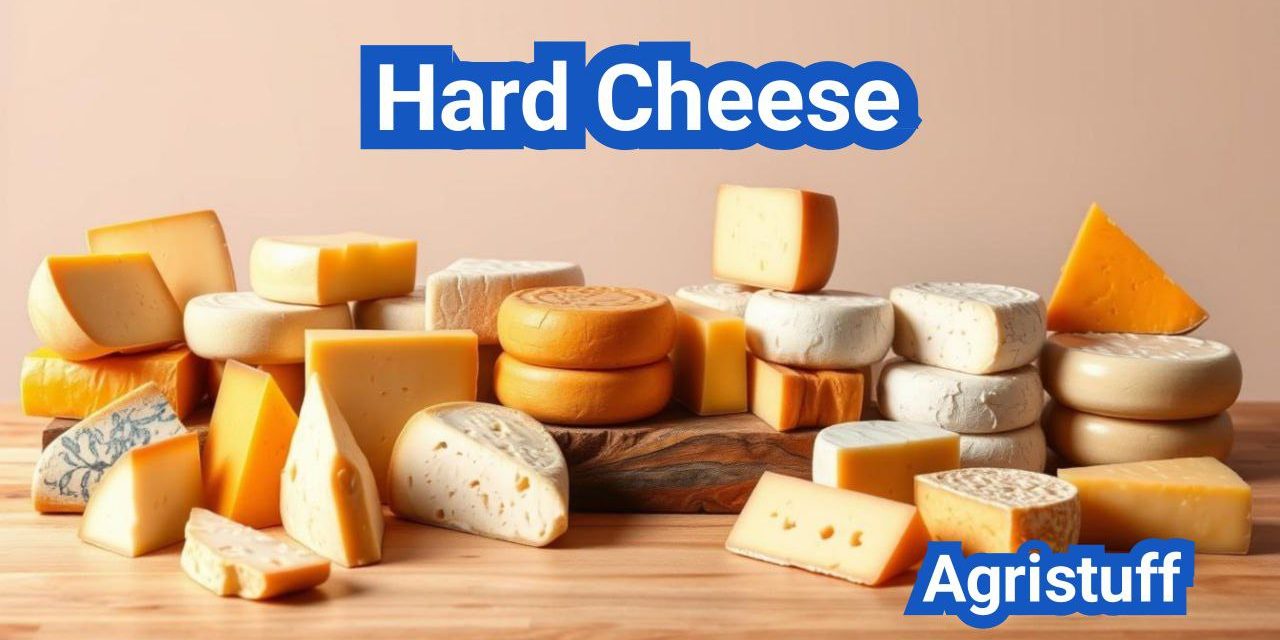Understanding Hard Cheese
Hard cheese is a category of cheese known for its low moisture content and dense texture, making it a favorite among cheese enthusiasts. Often aged for a longer period than soft cheese, it develops a rich flavor profile that can be enjoyed grated or sliced thinly.
The significance of hard cheese lies in its versatility and the variety of types available, each with its unique characteristics and uses. From being a key ingredient in various recipes to being enjoyed on its own, hard cheese adds depth and complexity to any culinary experience.
Key Takeaways
- Hard cheese is characterized by its low moisture content and dense texture.
- It is often aged for a longer period, developing a rich flavor profile.
- Various types of hard cheese offer unique characteristics and uses.
- Hard cheese is versatile and can be used in a variety of recipes.
- It can be enjoyed grated or sliced thinly, adding depth to culinary experiences.
What Is Hard Cheese?
The world of cheese is vast, and hard cheese stands out due to its distinctive characteristics and production process. Hard cheese is primarily defined by its aging process, which significantly reduces its moisture content, resulting in a harder texture and more concentrated flavor.
Definition and Basic Characteristics
Hard cheese is characterized by its low moisture content, typically below 30%, and a higher fat content compared to softer cheeses. This type of cheese is often aged for a long time, which contributes to its hard texture and rich flavor profile. The aging process involves regular turning and monitoring to prevent unwanted mold or bacterial growth.
Key characteristics of hard cheese include:
- Low moisture content
- Higher fat content
- Long aging process
- Dense and hard texture
- Rich and complex flavor profile
Historical Background
The history of hard cheese dates back centuries, with its origins rooted in traditional cheese-making practices across various regions. The development of hard cheese was largely driven by the need to preserve milk, as the aging process allowed cheese to be stored for longer periods without spoiling.
As noted by cheese historians, the art of cheese-making, including the production of hard cheese, was influenced by factors such as climate, geography, and cultural practices. For instance, the Swiss Alps and Italian regions have long been known for their traditional hard cheeses like Gruyère and Parmesan.
“Cheese is milk’s leap towards immortality.” – Clifton Fadiman
This quote encapsulates the transformation that milk undergoes to become cheese, a process that is particularly evident in the production of hard cheese, where patience and time result in a product that is both durable and rich in flavor.
The Science Behind Hard Cheese

Hard cheese production is a complex process that involves a thorough understanding of milk’s chemical makeup and the biochemical processes that convert it into cheese. The journey to creating high-quality hard cheese begins with the milk itself, which is composed of various elements that play crucial roles in the final product’s characteristics.
Milk Composition and Its Role
Milk is primarily made up of water, carbohydrates (lactose), proteins (casein and whey), and fats. The proportions of these components can significantly affect the cheese’s texture, flavor, and overall quality. For instance, the fat content in milk influences the richness and flavor of the cheese, while the protein structure is crucial for the cheese’s texture and its ability to age well.
Milk Fat and Protein: Key Components
- Milk fat contributes to the cheese’s flavor and texture.
- Casein proteins are essential for the curdling process.
- Whey proteins play a role in the cheese’s moisture content and texture.
| Milk Component | Role in Cheese Production |
|---|---|
| Fat | Influences flavor and texture |
| Casein | Crucial for curdling and texture |
| Whey | Affects moisture content and texture |
| Lactose | Converted to lactic acid, impacting flavor |
Chemical Processes During Cheese Making
The transformation of milk into hard cheese involves several critical chemical processes. One of the primary processes is the conversion of lactose into lactic acid by lactic acid bacteria. This conversion lowers the pH, which is essential for the coagulation of milk and the development of the cheese’s flavor.
The Coagulation Process
Coagulation is facilitated by the addition of rennet, an enzyme that helps to form a gel-like substance from the milk. This gel, or curd, is then cut, stirred, and cooked to release whey and create a smooth, even texture in the final cheese.
The aging process further involves complex biochemical reactions that develop the cheese’s characteristic flavors and textures. Understanding these processes is key to producing high-quality hard cheeses with distinct profiles.
Key Characteristics of Hard Cheese
Hard cheese stands out due to its unique combination of texture, moisture content, and durability. These characteristics not only define hard cheese but also influence its production, classification, and usage.
Texture and Structure
The texture of hard cheese is one of its most distinguishing features. It is typically dense and firm, making it grate well and hold its shape when sliced. This texture is a result of the cheese-making process, which involves curdling milk, separating curds from whey, and then pressing the curds to remove excess moisture.
The structure of hard cheese can vary, with some types having a smooth, even texture, while others may be more crumbly or have visible holes. For instance, Parmesan is known for its granular texture, whereas Gruyère has a richer, creamier texture with small holes.
Moisture Percentage and Classification
The moisture content in hard cheese is significantly lower compared to soft cheeses. This low moisture percentage is crucial for classifying cheese as “hard.” Generally, hard cheeses have a moisture content of less than 40%, which contributes to their durability and long shelf life.
The classification of cheese based on moisture content is as follows:
| Cheese Type | Moisture Content (%) |
|---|---|
| Soft Cheese | More than 50% |
| Semi-Soft Cheese | 40-50% |
| Hard Cheese | Less than 40% |
Shelf Life and Durability
Hard cheese is renowned for its long shelf life and durability. The low moisture content inhibits the growth of bacteria and mold, allowing hard cheese to be stored for extended periods. Proper storage conditions, such as keeping the cheese in a cool, dry place or wrapping it correctly, can further enhance its shelf life.
Some hard cheeses, like Aged Cheddar or Parmigiano-Reggiano, can be aged for several years, developing stronger flavors and textures over time. This aging process is a testament to the durability of hard cheese.
How to Make Hard Cheese at Home

With the right ingredients and equipment, you can successfully make hard cheese at home, enjoying the process and the delicious results. Making hard cheese involves a few key steps and components that, when combined, produce a rich and flavorful cheese.
Essential Ingredients
The basic ingredients for making hard cheese include high-quality milk, cheese cultures, rennet, and salt. The type of milk used can vary, with cow’s milk being common, but sheep’s or goat’s milk can also be used for different flavor profiles.
- Milk: Fresh and of high quality
- Cheese cultures: Specific to the type of cheese being made
- Rennet: Can be animal or microbial
- Salt: For flavor and preservation
Required Equipment
To make hard cheese, you’ll need specific equipment, including a large pot for heating the milk, a cheese mold to shape the cheese, and a cheese cloth or butter muslin for wrapping.
| Equipment | Description |
|---|---|
| Large Pot | For heating milk to the appropriate temperature |
| Cheese Mold | Shapes the cheese and allows it to drain |
| Cheese Cloth or Butter Muslin | Wraps the cheese, allowing it to age properly |
| Aging Refrigerator or Cave | Provides the controlled environment needed for aging |
Step-by-Step Production Method
The process of making hard cheese involves several steps, starting with heating the milk to a specific temperature, then adding the cheese cultures and rennet. After the curds have formed, they are cut, stirred, and cooked before being molded and aged.
- Heat the milk to the required temperature.
- Add cheese cultures and let it sit for a period.
- Add rennet to coagulate the milk.
- Cut and stir the curds.
- Cook the curds to remove excess whey.
- Mold the cheese and let it age.
Making hard cheese at home requires patience and attention to detail, but the result is a delicious, homemade cheese that can be enjoyed on its own or used in various recipes.
The Art of Aging Hard Cheese
Hard cheese aging is a nuanced process that requires patience, precision, and a deep understanding of cheese production. The art of aging hard cheese is what transforms it from a simple dairy product into a complex, flavorful delicacy.
Why Aging Matters
Aging is crucial for hard cheese as it allows the development of the cheese’s characteristic flavor and texture. During the aging process, various biochemical reactions occur that contribute to the complexity and depth of the cheese.
Flavor Development: As cheese ages, enzymes break down fats and proteins, resulting in the formation of compounds that contribute to its flavor. The longer a cheese is aged, the more pronounced its flavor becomes.
Optimal Conditions for Aging
To age hard cheese properly, specific conditions must be met. Temperature and humidity are critical factors that influence the aging process.
- Temperature Control: Most hard cheeses are aged at temperatures between 35°F and 55°F (2°C and 13°C). Consistent temperature is vital to prevent unwanted bacterial growth.
- Humidity: Maintaining the right humidity level is essential. Too little humidity can cause the cheese to dry out, while too much can lead to mold growth. The ideal humidity level varies depending on the type of cheese.
How Aging Affects Flavor and Texture
The aging process significantly impacts both the flavor and texture of hard cheese. As cheese ages, it loses moisture, becoming denser and more concentrated in flavor.
Texture Changes: The texture of hard cheese becomes more granular and crumbly with age. This is due to the breakdown of proteins and the loss of moisture.
Flavor Enhancement: Aging enhances the flavor of hard cheese, making it sharper and more complex. The development of crystals within the cheese, such as tyrosine crystals, can also add to its texture and flavor.
Hard Cheese vs. Soft Cheese: Key Differences
The world of cheese is diverse, with hard cheese and soft cheese representing two distinct categories. Understanding the differences between these two types can help cheese enthusiasts appreciate their unique characteristics and uses.
Production Methods Compared
The production process for hard cheese and soft cheese differs significantly. Hard cheese is made by heating curdled milk to a high temperature, then pressing it to remove excess liquid. This process, combined with aging, contributes to its firm texture. Soft cheese, on the other hand, is made with less heat and is not pressed, resulting in a higher moisture content.
Key differences in production include:
- Temperature: Hard cheese is heated to a higher temperature than soft cheese.
- Pressing: Hard cheese is pressed to remove excess liquid, while soft cheese is not.
- Aging: Hard cheese is typically aged longer than soft cheese.
Texture and Moisture Differences
The texture and moisture content of hard cheese and soft cheese are among their most noticeable differences. Hard cheese has a firm, dense texture due to its low moisture content. Soft cheese, with its higher moisture content, has a creamy or spreadable texture.
| Cheese Type | Moisture Content | Texture |
|---|---|---|
| Hard Cheese | Low | Firm, Dense |
| Soft Cheese | High | Creamy, Spreadable |
Flavor Profiles and Uses
The flavor profiles of hard cheese and soft cheese vary significantly due to their different production methods and aging processes. Hard cheese tends to have a richer, more concentrated flavor, while soft cheese often has a milder, creamier taste.
Uses in cooking also differ:
- Hard cheese is often grated over dishes or used in cooking for its flavor.
- Soft cheese is commonly used in spreads, sauces, or as a topping.
Hard Cheese vs. Semi-Hard Cheese: Understanding the Spectrum

In the realm of cheese, the distinction between hard and semi-hard varieties is rooted in their production and aging processes. Understanding these differences can help cheese enthusiasts make informed choices for their culinary needs.
Defining the Categories
Hard cheese is characterized by its low moisture content and firm texture, achieved through a longer aging process. Semi-hard cheese, on the other hand, falls between hard and soft cheeses in terms of texture and moisture content, offering a balance between the two extremes.
The classification of cheese into hard, semi-hard, or soft categories depends on factors such as moisture content, aging time, and production methods. Hard cheeses typically have a moisture content of less than 30%, while semi-hard cheeses range between 30% to 40% moisture content.
| Characteristics | Hard Cheese | Semi-Hard Cheese |
|---|---|---|
| Moisture Content | Less than 30% | 30% to 40% |
| Aging Time | Typically longer (6 months to several years) | Moderate (3 to 6 months) |
| Texture | Very firm, often granular | Firm but yielding to pressure |
Notable Differences in Production and Aging
The production process for hard cheese involves heating the curd to a higher temperature and applying more pressure to remove excess whey, resulting in a denser cheese. Semi-hard cheese production involves a moderate heating and pressing process, retaining more moisture than hard cheese.
Aging is another critical factor that differentiates hard cheese from semi-hard cheese. Hard cheeses are aged for longer periods, which concentrates their flavors and textures. Semi-hard cheeses are aged for a shorter duration, preserving a milder flavor and a smoother texture.
“The art of aging cheese is a delicate balance between time, temperature, and humidity, transforming the cheese’s character over time.” – Cheese Expert
When to Choose Each Type
Choosing between hard and semi-hard cheese depends on the intended use and personal preference. Hard cheeses are ideal for grating over dishes, adding a sharp flavor, while semi-hard cheeses are great for slicing and serving on a charcuterie board.
For cooking, hard cheeses like Parmesan are perfect for adding depth to sauces and soups. Semi-hard cheeses, such as Gouda, melt well and are suitable for grilled cheese sandwiches or baked dishes.
In conclusion, understanding the spectrum between hard and semi-hard cheese can enhance your culinary experiences by helping you select the right cheese for your needs.
Types of Hard Cheese Around the World

From the Alps to the Americas, hard cheese has become an integral part of local cuisines, showcasing a wide range of flavors and textures. This diversity is a result of centuries-old traditions, local ingredients, and unique production methods.
European Traditions
Europe is renowned for its rich variety of hard cheeses, each with its own distinct characteristics. Countries like Italy, Switzerland, and France are particularly famous for their hard cheese production.
- Italian Hard Cheeses: Parmesan, known as Parmigiano-Reggiano, is one of the most celebrated Italian hard cheeses, aged for a minimum of 12 months.
- Swiss Hard Cheeses: Gruyère and Sbrinz are notable examples, often used in fondue and other traditional dishes.
- French Hard Cheeses: Comté and Beaufort are prime examples, known for their nutty flavors and firm textures.
“The art of cheese making is a tradition passed down through generations, with each region adding its unique twist.” –
Cheesemaker’s Guild
American Hard Cheeses
The United States has developed its own unique hard cheese styles, often influenced by European traditions but with an American twist.
| Cheese Name | Region | Description |
|---|---|---|
| Aged Cheddar | Wisconsin | A sharp, tangy cheese often used in cooking and grating. |
| Sap Sago | New England | A traditional American hard cheese, known for its strong flavor and conical shape. |
Other Global Varieties
Beyond Europe and America, other parts of the world also produce unique hard cheeses, reflecting local tastes and milk sources.
- Australian Hard Cheeses: Often made from cow’s or sheep’s milk, these cheeses are known for their rich flavors and dense textures.
- South American Hard Cheeses: Cheeses like “Queso fresco” type hard cheeses are found in some regions, offering a fresh, crumbly texture.
The global diversity of hard cheese is a testament to the versatility and enduring appeal of this dairy product. Whether you’re a cheese aficionado or just discovering the world of hard cheeses, there’s always something new to explore.
Comprehensive List of Hard Cheeses

The world of hard cheese is vast and varied, with different regions offering their unique takes on this beloved dairy product. Hard cheese has become a staple in many cuisines around the globe, with each region contributing its own distinct varieties.
Italian Hard Cheeses
Italy is renowned for its rich tradition of cheese making, and hard cheeses are no exception. Some of the most famous Italian hard cheeses include:
- Parmesan (Parmigiano-Reggiano): Known for its granular texture and sharp, salty flavor, often grated over pasta dishes.
- Pecorino Romano: A sharp, salty cheese made from sheep’s milk, often used in Italian cuisine for grating.
- Grana Padano: Similar to Parmesan but with a milder flavor, used in a variety of dishes.
Swiss and Alpine Hard Cheeses
Switzerland and the Alpine regions are home to some of the world’s most celebrated hard cheeses, known for their rich flavors and smooth textures.
| Cheese Name | Region | Description |
|---|---|---|
| Gruyère | Switzerland | A nutty, creamy cheese perfect for fondue or grating. |
| Emmental | Switzerland | Known for its large holes and mild, slightly sweet flavor. |
| Sbrinz | Switzerland | A strong, pungent cheese often used grated. |
“The art of making cheese is a tradition passed down through generations, with each region adding its unique twist.” –
A cheese artisan
British and Irish Hard Cheeses
The British Isles also boast a rich tradition of hard cheese production, with a variety of cheeses that are both flavorful and versatile.
- Cheddar: Originating from England, Cheddar is one of the most popular hard cheeses worldwide, available in a range of ages.
- Lancashire: A crumbly cheese from England, great for salads or as a snack.
- Dublin Blue: An Irish blue cheese with a strong, tangy flavor.
These regional hard cheeses not only showcase the diversity within the category but also highlight the unique characteristics imparted by local traditions and environments.
Popular Hard Cheese Examples and Their Unique Profiles

From the sharpness of aged Cheddar to the nuttiness of Gruyère, popular hard cheeses offer a wealth of flavors. These cheeses have gained worldwide recognition for their distinct characteristics and uses in culinary applications.
Parmesan and Pecorino
Parmesan, also known as Parmigiano-Reggiano, is a staple in Italian cuisine, renowned for its granular texture and sharp, salty flavor. It’s often grated over pasta dishes, salads, and soups. Pecorino, another Italian cheese, is made from sheep’s milk and has a tangy, slightly sweet flavor profile. Both are aged for a significant period, which contributes to their hard texture and rich taste.
“Parmesan is the king of cheeses,” a saying that reflects its popularity and versatility in cooking. Its aging process can last from 12 to 36 months or more, developing a deeper flavor over time.
Aged Cheddar and Extra Mature Varieties
Aged Cheddar is a favorite among cheese enthusiasts, with its flavor profile ranging from mild and creamy to sharp and tangy, depending on the aging duration. Extra-mature Cheddar, aged for over two years, develops a particularly robust flavor, making it ideal for snacking or grating.
The aging process for Cheddar involves careful temperature and humidity control, allowing the cheese to mature slowly and develop its characteristic taste. As Master cheese makers would attest, the art of aging Cheddar is both a science and an art.
Gruyère and Comté
Gruyère and Comté are two French cheeses known for their rich, nutty flavors and smooth textures. Gruyère is often used in fondue and grilled cheese, while Comté is appreciated for its subtle fruit notes and firm texture. Both are produced in specific regions of France and Switzerland, adhering to traditional methods.
Gruyère’s flavor is often described as creamy and slightly sweet, with a hint of nuttiness. Comté, on the other hand, has a more pronounced fruitiness, making it a versatile choice for both cooking and serving as a table cheese.
Manchego and Gouda
Manchego, a Spanish cheese, is made from sheep’s milk and has a nutty, slightly sweet flavor. It’s often served as a tapas or used in cooking. Gouda, originating from the Netherlands, comes in various ages, from young and mild to aged and sharp. Both cheeses are popular for their rich flavors and versatility.
Manchego’s firm texture makes it an excellent choice for slicing and serving. Gouda, depending on its age, can range from smooth and creamy to sharp and crumbly, offering a variety of uses in the kitchen.
Nutritional Profile of Hard Cheese

Hard cheese is renowned for its rich nutritional profile, making it a valuable addition to a balanced diet. As a nutrient-dense food, it provides a range of essential nutrients that contribute to overall health and well-being.
Macronutrients in Hard Cheese
Hard cheese is an excellent source of macronutrients, including protein, fat, and to a lesser extent, carbohydrates. The protein content in hard cheese is particularly significant, making it a good option for individuals looking to increase their protein intake. For instance, a single ounce of Parmesan cheese contains about 6.8 grams of protein. The fat content, while significant, is primarily composed of saturated fats, which have been a topic of discussion regarding their impact on heart health.
Key macronutrient highlights in hard cheese include:
- High protein content
- Significant fat content, primarily saturated
- Low carbohydrate content
Vitamins and Minerals
Hard cheese is also a rich source of various vitamins and minerals. It is particularly known for its high calcium content, which is crucial for bone health. Additionally, hard cheese contains other essential minerals like phosphorus, zinc, and potassium. Vitamins such as vitamin A, vitamin B12, and riboflavin are also present in significant amounts.
Notable vitamins and minerals in hard cheese:
- Calcium: Essential for bone health
- Vitamin B12: Important for nerve function and red blood cell formation
- Phosphorus: Crucial for the formation of bones and teeth
“Cheese, particularly hard cheese, is a nutritional powerhouse that can be part of a healthy diet when consumed in moderation.” – Nutrition Expert
Health Benefits and Considerations
The nutritional profile of hard cheese translates into several health benefits. The high calcium and phosphorus content supports bone health, potentially reducing the risk of osteoporosis. The protein content aids in muscle maintenance and repair. However, due to its high saturated fat and sodium content, moderation is key to avoiding potential negative impacts on heart health and blood pressure.
Health considerations:
- Supports bone health
- Aids in muscle maintenance
- Should be consumed in moderation due to high saturated fat and sodium
Hard Cheese for Special Dietary Needs

The aging process involved in making hard cheese reduces its lactose content, potentially making it more suitable for those with lactose intolerance. This characteristic makes hard cheese an attractive option for individuals who need to limit their lactose intake but still wish to enjoy cheese.
Lactose Content in Hard Cheese
Hard cheese generally has a lower lactose content compared to softer cheeses. This is because the aging process involves bacteria consuming much of the lactose, resulting in a product that is lower in lactose. Cheeses like Parmesan, aged Cheddar, and Gruyère are examples where the lactose is significantly reduced during aging.
The process of making hard cheese involves heating the curd to high temperatures and aging it for a long period. This not only enhances the flavor and texture but also reduces the lactose content, making it more tolerable for individuals with lactose intolerance.
Best Hard Cheese Options for Lactose Intolerance
For those with lactose intolerance, certain hard cheeses are better options than others. Parmesan, for instance, is aged for a minimum of 12 months, during which time most of its lactose is consumed by bacteria. Similarly, Gruyère and aged Cheddar are good choices due to their low lactose content.
When selecting hard cheese, it’s also important to consider the aging time. Generally, the longer a cheese is aged, the lower its lactose content will be. Thus, opting for harder, aged cheeses can be a good strategy for managing lactose intake.
Some of the best hard cheese options for those with lactose intolerance include:
- Parmesan: Aged for at least 12 months, making it very low in lactose.
- Gruyère: Aged for several months, which reduces its lactose content.
- Aged Cheddar: The aging process significantly reduces its lactose levels.
- Manchego: A Spanish cheese that is aged and has lower lactose content.
Culinary Uses of Hard Cheese

With its rich flavor and firm texture, hard cheese is ideal for grating, cooking, and pairing with a variety of foods and drinks. Hard cheese can be used in numerous culinary applications, from adding a sprinkle of grated cheese to pasta dishes to serving as a centerpiece for a charcuterie board.
Best Hard Cheeses for Grating and Cooking
Some hard cheeses stand out for their grating and cooking qualities. Parmesan and Pecorino Romano are popular choices for grating over pasta, salads, and soups due to their sharp, salty flavors. Gruyère and Comté are excellent for cooking, as they melt well and add a rich, nutty flavor to dishes like fondue and quiches.
- Parmesan: Ideal for grating over pasta and salads.
- Pecorino Romano: Adds a sharp, salty flavor to dishes.
- Gruyère: Excellent for melting in fondue and quiches.
- Comté: Offers a rich, nutty flavor when melted.
Cooking Applications and Recipes
Hard cheese can be incorporated into a wide range of recipes. For instance, a classic Mac and Cheese recipe can be elevated with the use of hard cheeses like Cheddar or Gouda. Hard cheese can also be used to make a delicious Cheese Fondue by melting it with wine and serving it with bread or vegetables.
Here’s a simple recipe for a Cheesy Baked Pasta:
Ingredients: 1 cup grated hard cheese (Parmesan or Gruyère), 1 cup pasta, 2 cups béchamel sauce, 1/4 cup breadcrumbs. Instructions: Mix cooked pasta with béchamel sauce and grated cheese. Transfer to a baking dish, top with more grated cheese and breadcrumbs, and bake until golden.
Pairing with Other Foods and Beverages
Hard cheese can be paired with a variety of foods and beverages to enhance its flavor. For example, Manchego pairs well with membrillo, a sweet quince paste, while Gouda can be paired with fruit preserves. Hard cheeses also complement wines and beers; Parmigiano-Reggiano is often served with a glass of red wine.
| Hard Cheese | Pairing Suggestion |
|---|---|
| Manchego | Membrillo or almonds |
| Gouda | Fruit preserves or crackers |
| Parmigiano-Reggiano | Red wine or balsamic vinegar |
Creating the Perfect Charcuterie Board with Hard Cheese
Creating a charcuterie board with hard cheese is an art that requires careful selection and presentation. A well-curated board can elevate any gathering, offering a variety of flavors and textures that delight the palate.
Selection Principles for Hard Cheese Varieties
When selecting hard cheeses for your charcuterie board, consider a mix of flavors and textures. Parmigiano-Reggiano and Pecorino Romano offer sharp, salty flavors, while Gruyère and Comté provide nutty, slightly sweet notes. Including a variety of aged cheeses, such as extra mature cheddar, adds depth to the board.
| Cheese Type | Flavor Profile | Texture |
|---|---|---|
| Parmigiano-Reggiano | Sharp, salty | Granular, crumbly |
| Gruyère | Nutty, slightly sweet | Creamy, firm |
| Extra Mature Cheddar | Rich, tangy | Hard, crumbly |
Complementary Elements and Accompaniments
A charcuterie board is not just about cheese; it’s about creating a harmonious balance of flavors and textures. Cured meats like prosciutto and salami add a savory element, while fruits such as apples and grapes provide a refreshing contrast. Nuts, like almonds and walnuts, offer a satisfying crunch.
- Cured meats (e.g., prosciutto, salami)
- Fruits (e.g., apples, grapes)
- Nuts (e.g., almonds, walnuts)
- Breads and crackers
- Jams and chutneys
Presentation Tips and Serving Suggestions
Presentation is key to a successful charcuterie board. Arrange cheeses and accompaniments in a visually appealing manner, using a variety of heights and textures. Consider using a wooden board or slate as the base. Labeling the different cheeses and meats can add an educational element, enhancing the guest experience.
By carefully selecting a variety of hard cheeses and complementary elements, and presenting them in an attractive manner, you can create a charcuterie board that is both inviting and memorable.
Proper Storage and Handling of Hard Cheese
Hard cheese requires specific storage conditions to preserve its flavor and texture. Proper storage involves maintaining appropriate temperature and humidity levels, as well as using suitable wrapping methods and storage containers.
Temperature and Humidity Considerations
The ideal storage temperature for hard cheese is between 35°F and 45°F (2°C and 7°C). Consistent refrigeration is crucial to prevent the growth of unwanted bacteria and mold. Humidity is also a critical factor; a relative humidity of 70% to 80% is recommended to keep the cheese from drying out.
To achieve the right humidity, you can store the cheese in the refrigerator’s vegetable drawer or use a cheese storage container that maintains humidity. Monitoring the storage environment is essential to ensure the cheese ages properly without spoiling.
| Storage Condition | Ideal Range |
|---|---|
| Temperature | 35°F – 45°F (2°C – 7°C) |
| Relative Humidity | 70% – 80% |
Wrapping Methods and Storage Containers
Wrapping hard cheese correctly is vital to prevent it from drying out or absorbing odors from other foods. Parchment paper or wax paper is recommended for wrapping cheese, as they allow it to breathe while protecting it from contamination. For long-term storage, consider using a cheese storage bag or an airtight container.
It’s also important to note that different types of hard cheese may require specific wrapping methods. For instance, aged cheeses may benefit from being wrapped in a breathable material to allow them to age properly.
By following these guidelines for temperature, humidity, and wrapping, you can enjoy your hard cheese at its best quality for a longer period.
Appreciating the World of Hard Cheese
The world of hard cheese is a rich and diverse one, offering a wide range of flavors, textures, and culinary applications. From the nutty, crumbly texture of Parmesan to the smooth, mellow taste of aged Gouda, hard cheese has something to offer every palate.
Throughout this article, we’ve explored the characteristics, production methods, and uses of hard cheese, highlighting its unique qualities and the various ways it can be enjoyed. Whether you’re a cheese aficionado or just discovering the joys of hard cheese, there’s no denying the appeal of this versatile and delicious category.
As you continue to explore the world of hard cheese, we encourage you to appreciate the craftsmanship and tradition that goes into creating these exceptional cheeses. With its rich flavors and numerous uses, hard cheese is sure to remain a staple in many cuisines around the world, inviting you to savor and appreciate its many wonders.
FAQ
What is hard cheese?
Hard cheese is a type of cheese that has a low moisture content, typically below 35%, and is often aged for a long period, resulting in a firm texture and rich flavor.
How is hard cheese made?
Hard cheese is made by heating curdled milk, separating the curds from the whey, shaping the curds, and then aging the cheese to develop its characteristic flavor and texture.
What are the characteristics of hard cheese?
Hard cheese is known for its firm texture, granular or crystalline structure, and long shelf life due to its low moisture content.
What are some examples of hard cheese?
Examples of hard cheese include Parmesan, Pecorino, Cheddar, Gruyère, Comté, Manchego, and Gouda, among others.
Is hard cheese suitable for lactose intolerance?
Hard cheese generally has lower lactose levels due to the aging process, making it a more tolerable option for those with lactose intolerance, but it’s still important to check individual tolerance.
How should hard cheese be stored?
Hard cheese should be stored in a cool, humid environment, wrapped in a breathable material like wax paper or cheese cloth, and kept away from strong-smelling foods.
Can hard cheese be frozen?
While it’s technically possible to freeze hard cheese, it’s not recommended as it can affect the texture and flavor; if freezing, it’s best to grate or shred the cheese first.
What are the best hard cheeses for grating?
Parmesan, Pecorino, and Grana Padano are popular hard cheeses for grating due to their granular texture and rich flavor.
How can hard cheese be used in cooking?
Hard cheese can be grated or shredded and used in a variety of dishes, such as pasta, salads, soups, and sauces, adding depth and richness to the flavors.
What are some tips for creating a charcuterie board with hard cheese?
When creating a charcuterie board, select a variety of hard cheeses, pair them with complementary elements like cured meats, fruits, and nuts, and consider the visual presentation.
What is the nutritional profile of hard cheese?
Hard cheese is typically high in protein, fat, and calories, but also rich in vitamins and minerals like calcium, phosphorus, and zinc.
How does the aging process affect hard cheese?
The aging process can significantly impact the flavor and texture of hard cheese, with longer aging times often resulting in a stronger, more complex flavor profile.
Conclusion of: Hard Cheese | A Comprehensive Guide
Hard Cheese: Meaning and Why It Matters
In dairy science and labeling, hard cheese refers to a broad category of firm, low-moisture cheeses defined in U.S. standards of identity; they’re produced by coagulating milk, forming curd, pressing, salting, and ripening to achieve a dense texture and concentrated flavor that consumers and chefs love. U.S. FDA eCFR: §133.150 Hard cheeses
Hard Cheese vs. Other Styles (The Technical Meaning)
Scientifically, hard cheese falls on the drier end of the moisture spectrum; globally, cheesemakers often classify cheeses by moisture on a fat-free basis (MFFB), where “hard” and “extra-hard” sit below semi-hard and soft styles—this moisture metric helps predict texture, ageability, and culinary performance. International Dairy Federation: Cheese factsheet
Key Characteristics of Hard Cheese
Legally in the U.S., hard cheese has ≤39% moisture and typically ≥50% milkfat in the solids; this low moisture yields longer shelf life, a firm or sometimes granular bite, and an intense, savory profile that grates cleanly and melts with structure rather than runniness. FDA Food Code 2022 (Cheese moisture thresholds)
How Hard Cheese Is Made (Overview)
From vat to cave, hard cheese production follows a common flow: ripen milk with starter cultures, coagulate with rennet, cut curd finely to expel whey, cook/stir, drain, press into molds, salt (brine or dry), then age under controlled conditions to develop texture and flavor. University of Guelph: Cheese Making Technology (Basic Process)
From Curd to Wheel: What Drives Firmness
The small curd size, higher cook temperatures, pressing pressure, and salting regime are the levers that make hard cheese firm; these choices push out moisture, set the protein matrix, and prepare the wheel for long ripening without defects. University of Guelph: Cheesemaking step-by-step
Aging & Crystals: The Signature Crunch
During maturation, proteolysis and changes in calcium and lactate can create tiny crystals that give hard cheese its prized “crunch”; scientists note both tyrosine and calcium-lactate crystals can form, influencing texture and consumer perception in aged styles. Journal of Dairy Science: Crystals in cheese (review)
Nutrition Snapshot of Hard Cheese
Per ounce, hard cheese like Parmesan or aged Cheddar typically delivers high-quality protein, calcium, phosphorus, vitamin A, and energy—nutrient density rises as water falls, which is why hard styles pack robust calories and minerals in small portions. MyFoodData (USDA-based): Parmesan nutrition
Hard Cheese and Lactose Intolerance
Thanks to fermentation and aging that consume lactose, most hard cheese varieties (like Cheddar or Swiss) are naturally low in lactose and are often better tolerated than fresh dairy, though tolerance varies by individual and servings should be tested prudently. NIH NIDDK: Eating & nutrition for lactose intolerance
Food Safety: Mold, Storage & Shelf Life
At home, unopened hard cheese can refrigerate safely for months; after opening, trim at least 1 inch around and below any surface mold (don’t touch the knife to the mold) and rewrap properly to discourage spoilage. USDA FSIS: Molds on food (hard cheese guidance)
Storage Tips That Preserve Quality
To keep hard cheese flavorful and moist, wrap in parchment/wax or cheese paper and store in a breathable container; the USDA’s cold-storage guidance suggests 3–4 weeks after opening for blocks and roughly a month for shredded hard styles. USDA Ask: Dairy product timeframes
How Cooks Use Hard Cheese
Because it grates cleanly and melts without greasiness, hard cheese is ideal for finishing pasta, risotto, soups, vegetables, and salads; on boards, pair with toasted nuts, firm fruit, and wines that match intensity for a balanced sensory experience. American Cheese Society: Serving & pairing tips
Buying & Labeling: U.S. Standards to Know
When shopping, the term hard cheese on American labels can reference several specific standards—e.g., “Parmesan and reggiano” have their own identity (§133.165) while generic “hard cheeses” are covered by §133.150—so reading the ingredient and identity statement helps you pick authentic styles. LII: §133.165 Parmesan and reggiano cheese
Hard Cheese Types: Parmigiano Reggiano (Italy)
Often called the “king,” this granular hard cheese is cooked, pressed, brined, and aged a minimum of 12 months (commonly 24+), yielding intense umami, a crystalline crunch, and superb grating performance over pasta and vegetables. Parmigiano Reggiano Consortium: Specifications
Hard Cheese Types: Grana Padano (Italy)
With a protected designation and long aging, this crumbly hard cheese offers a slightly milder, buttery profile than Parmigiano and is widely used grated into soups, risottos, and sauces. Consorzio Grana Padano: Aging
Hard Cheese Types: Pecorino Romano (Italy)
Saltier and sharper, this sheep’s milk hard cheese is a classic for Cacio e Pepe and Amatriciana, prized for assertive salinity and muscular umami that stand up to bold dishes. Consorzio Pecorino Romano
Hard Cheese Types: Asiago d’Allevo (Italy)
Aged Asiago d’Allevo evolves from elastic to firmer and more crumbly with time; as a matured hard cheese, it delivers nutty sweetness and grates beautifully over roasted vegetables. Consorzio Tutela Formaggio Asiago
Hard Cheese Types: Manchego Curado/Gran Reserva (Spain)
Produced in La Mancha from Manchega sheep, aged versions of this iconic hard cheese develop a firm, sliceable yet grate-worthy texture with toasted, savory notes ideal for tapas. D.O.P. Queso Manchego: Regulator
Hard Cheese Types: Gruyère AOP (Switzerland)
Famed for fondue and table service, Gruyère as a matured hard cheese shows elastic-to-firm paste with complex caramelized flavors, making it excellent for gratins and sandwiches. Le Gruyère AOP (official)
Hard Cheese Types: Comté AOP (France)
Made in the Jura from raw cow’s milk, aged Comté is a benchmark alpine hard cheese, delivering layered hazelnut, brown butter, and orchard fruit notes that shine on boards and in savory bakes. Comté AOP (official)
Hard Cheese Types: Aged Cheddar (UK/US)
Cheddar transitions from firm to truly hard cheese as it ages, concentrating acidity and savory depth; PDO West Country Farmhouse Cheddar denotes traditional production in specific English counties. UK GOV: West Country Farmhouse Cheddar PDO
Hard Cheese Types: Sbrinz AOP (Switzerland)
Among Europe’s oldest, Sbrinz is an extra-hard cheese—arguably denser than many—whose lengthy aging crafts a brittle texture and deep savory intensity that make it a grating-first hard cheese. Sbrinz AOP (official)
Quick List of Popular Hard Cheeses
For shopping and menu planning, consider these hard cheese staples: Parmigiano Reggiano, Grana Padano, Pecorino Romano, aged Asiago, aged Cheddar, Comté, Gruyère, Sbrinz, Piave, Fiore Sardo, and dry Jack; U.S. regulators include Cheddar, Romano, and Parmesan as examples under the hard-cheese umbrella. FDA: Food Traceability List (hard cheese examples)
Kitchen Uses: Grating, Shaving, and Melting
Grate hard cheese finely for sauces and finishing, shave it into salads or carpaccio for texture, or cube it for snack boards; its dense protein matrix resists greasiness, offering controlled melt in gratins, casseroles, and baked pastas. Wisconsin Cheese: Defining hard cheese & aging
Health & Menu Tips for U.S. Diners
Because hard cheese is calorie-dense, a little goes a long way—pair 1–2 oz with fiber-rich sides, and for those with lactose concerns, trial small portions of aged styles like Cheddar, Swiss, or Parmesan as tolerated with meals. NIH NIDDK: Lactose intolerance nutrition tips
Final thought
From the cave to your kitchen, hard cheese delivers unmatched flavor density, longevity, and culinary versatility; understanding its definitions, production, and care helps you buy wisely, store safely, and cook confidently for consistently excellent results. American Cheese Society: Tips for cheese lovers
Sources & References
- U.S. FDA eCFR §133.150 Hard cheeses
- LII: §133.165 Parmesan and reggiano cheese
- FDA Food Code 2022 (Cheese moisture thresholds)
- International Dairy Federation: Cheese fact sheet (MFFB classifications)
- University of Guelph: Cheese Making Technology (Process)
- Journal of Dairy Science: Crystals in cheese (review)
- MyFoodData (USDA-based): Parmesan nutrition
- NIH NIDDK: Lactose intolerance (diet & nutrition)
- USDA FSIS: Molds on food (hard cheese guidance)
- USDA Ask: Dairy product storage timeframes
- Parmigiano Reggiano Consortium
- Consorzio Pecorino Romano
- D.O.P. Queso Manchego
- Le Gruyère AOP
- Comté AOP (official)
- FDA: Food Traceability List (hard cheese examples)
- American Cheese Society: Tips for cheese lovers













